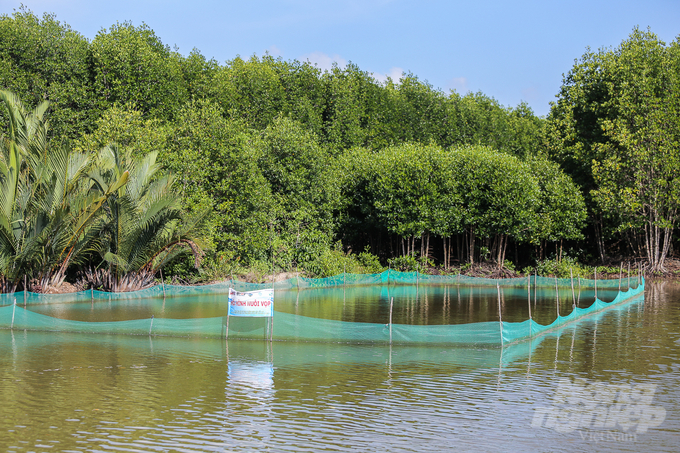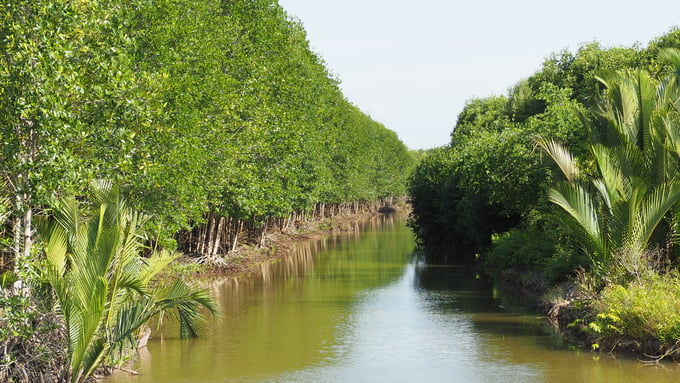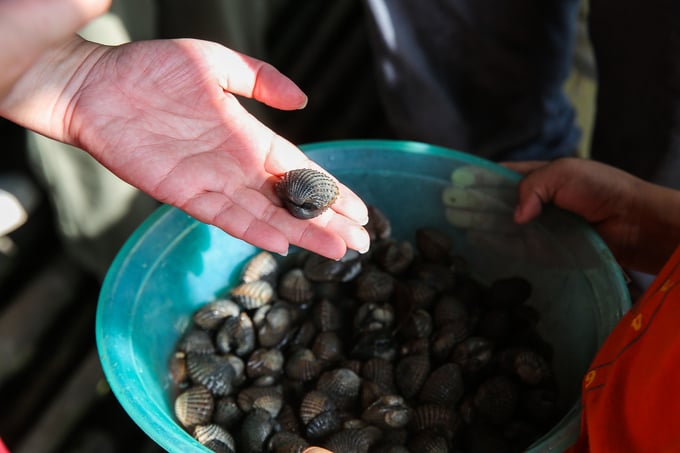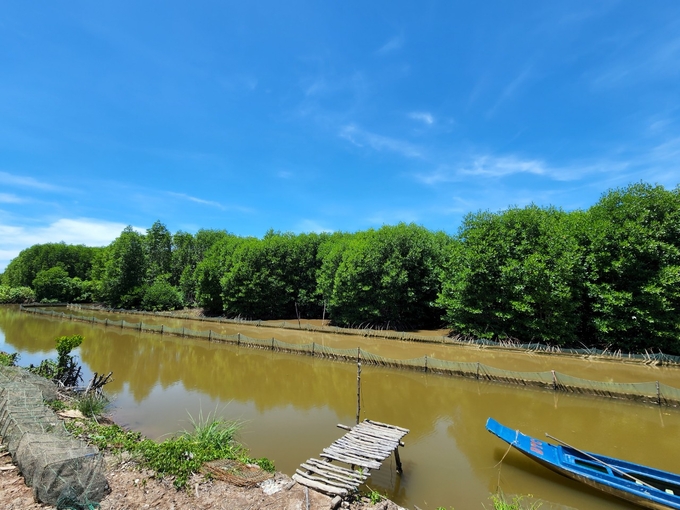November 21, 2025 | 10:20 GMT +7
November 21, 2025 | 10:20 GMT +7
Hotline: 0913.378.918
November 21, 2025 | 10:20 GMT +7
Hotline: 0913.378.918

A model of clam farming under forest canopies in Ngoc Hien District. Photo: Trong Linh.
Ca Mau Province hosts an extensive range of economically valuable and culturally significant products rooted in its fertile alluvial terrain, earning it the reputation as a region of treasures. This abundance has fostered a unique and rich forest ecosystem. By utilizing these natural advantages, residents of the mangrove areas in Ngoc Hien District have developed sustainable livelihoods tied to the forest, enabling many to achieve prosperity.
Originally a resident of northern Vietnam, Nguyen Duc Toan, an official working for a forest protection management board in Ngoc Hien District, made the decision to establish a career in the southernmost tip of the country.
"When I left the North to start a new life here, I was only a young graduate in my twenties, with little knowledge of Ca Mau Province and Ngoc Hien District. All I knew from literature was that Ca Mau was a land of mosquitoes, snakes, and leeches—an untamed wilderness with harsh waters. However, after joining the forest management board and patrolling the woods daily, I fell in love with the natural scenery and decided to stay ever since. This place is now my second home. I cherish the sincere, harmonious, and honest people of this land," Toan shared warmly about his connection to Dat Mui, Ca Mau.

Mangrove forest in Tam Giang Commune, Ngoc Hien District. Photo: Trong Linh.
Regarding the mangrove ecosystem in the Ca Mau Cape, Toan explained that the region is a young alluvial zone, with its surface formed by sediment materials brought from the river, which settle in the coastal marine environment and transition into a brackish wetland. The alluvial region at the Ca Mau Cape features a unique tidal regime due to its proximity to two seas with different tidal patterns.
"The eastern coast experiences a mixed semidiurnal tide, with a large tidal range of 2.5–3 meters, while the western coast follows a diurnal tide, with a tidal range of 1–1.5 meters during high tide. The tidal flow from the east pushes water deep into the inland, while the western tides tend to pull water out to the sea. This advantage supports the growth of marine species such as clams, oysters, and snails, which thrive and contribute to the area's high economic value," Mr. Toan remarked.
Tiet Huu Thanh, a forest protection officer at Dat Mui, Ngoc Hien District, commented that Ca Mau's mangrove forests boast immense ecological value, playing a vital role in protecting the region against winds and erosion. Furthermore, the mangrove ecosystem is crucial for maintaining ecological balance; preserving water quality by retaining soil, sediment, and organic matter; and filtering pollutants through vegetation and sedimentation processes.
"Under the influence of freshwater currents from the large rivers, which bring an abundance of nutrients and various aquatic larvae. The environment supports a sustainable ecosystem for the province’s 280,000 hectares of aquaculture. This contributes to stable yields, enhances the effectiveness of the aquaculture strategy, promotes comprehensive economic growth, and reduces poverty. The Ca Mau Cape hosts significant potential for eco-tourism, international cooperation, and scientific research," Thanh shared.

Blood cockle farming model in Tam Giang Dong Commune, Ngoc Hien District. Photo: Trong Linh.
Along with its unique and exceptional advantages, the mangrove forest ecosystem provides diverse and abundant livelihoods for local residents and enables them to profit through eco- and community-based tourism. This form of tourism has been rapidly developing in Ca Mau Cape for several years.
Huynh Van Lap, a resident of Ngoc Hien District, shared: "The Ca Mau mangrove ecosystem is highly diverse, offering valuable economic benefits under the forest canopy. It serves as a sanctuary for many rare species such as otters, cobras, and monkeys. With such a fertile ecosystem, tourists are eager to visit Ca Mau Cape to experience forest trekking, shrimp trap harvesting, mud walking for crabs, and fishing for mudskippers."
Le Minh Ty, Director of Tu Ty Company in Ngoc Hien District, shared: "Taking advantage of the forest's benefits, I made the bold decision to invest in the tourism sector. In addition to enjoying local dishes rich in alluvial flavor, visitors can engage in hands-on activities such as shrimp trap harvesting, net fishing, and catching their own fish and shrimp, which are then cooked and served at the shrimp farm. Many tourists enjoy this experience and choose to participate in these activities."

Ca Mau has effectively developed its eco-tourism and community-based tourism destinations. Photo: Trong Linh.
Regarding the potential and strengths of the forest ecosystem, Le Chi Thang, Head of the Ngoc Hien District's Department of Culture, Information, and Sports, shared: "Ngoc Hien boasts multiple advantages for tourism development, with diverse and abundant natural resources, particularly a rich mangrove forest ecosystem that supports various livelihoods. To utilize these advantages, the district has coordinated with the Ca Mau Cape National Park and provincial agencies to establish and promote distinctive tourism products, such as forest tours. At the same time, we have maximized the potential of eco-tourism and community-based tourism sites with attractive offerings."
According to Le Chi thang, these tourism products are deeply rooted in the unique culture of the riverine region of Ca Mau.
Translated by Nguyen Hai Long

(VAN) This is the study conducted by IRRI and Can Tho University on the rice straw value chain in Mekong Delta showing an economic potential of more than 6.6 trillion VND/year.

(VAN) By participating in cooperative economics, many farmers in Tay Ninh have overcome hardship, mastered clean dragon fruit cultivation techniques.

(VAN) The crossbreeding program in the former Binh Dinh province (now part of Gia Lai) has shown signs of decline, and urgent measures are needed to revive it and sustain past achievements.

(VAN) The agricultural sector agreed on a roadmap to pilot the MRV protocol and expand low-emission rice production from the 2025-2026 winter-spring crop.

(VAN) Agricultural extension officers in Quang Ninh do more than transmit knowledge; they have become a steadfast support system for farmers on the path to sustainable agricultural development.

(VAN) The development of a high-quality beef cattle herd has brought major benefits to livestock farmers, creating jobs and enabling better use of agricultural by-products.

(VAN) In the eastern region of Gia Lai, crossbred cattle now account for 93%, forming a high-quality beef herd and establishing a recognized brand, the result of 35 years of persistent effort.